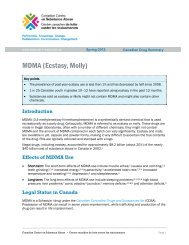CCSA-Drug-per-Se-Laws-Policy-Brief-2014-en
CCSA-Drug-per-Se-Laws-Policy-Brief-2014-en
CCSA-Drug-per-Se-Laws-Policy-Brief-2014-en
Create successful ePaper yourself
Turn your PDF publications into a flip-book with our unique Google optimized e-Paper software.
<strong>Drug</strong>-Per-<strong>Se</strong>-<strong>Laws</strong><br />
Background<br />
Canada has had an alcohol <strong>per</strong> se law since 1969. <strong>Se</strong>ction 253b of the Criminal Code makes it an<br />
off<strong>en</strong>ce to o<strong>per</strong>ate, or have care or control of, a vehicle with a blood alcohol conc<strong>en</strong>tration (BAC) in<br />
excess of 80 milligrams of alcohol in 100 millilitres of blood (80 mg/dL). This level of alcohol is<br />
deemed to be consist<strong>en</strong>t with significant psychomotor impairm<strong>en</strong>t and increased risk of crash<br />
involvem<strong>en</strong>t. It is also an off<strong>en</strong>ce to o<strong>per</strong>ate a vehicle while one’s ability to do so is impaired by<br />
alcohol, a drug or a combination of alcohol and a drug (<strong>Se</strong>ction 253a of the Criminal Code).<br />
Canada curr<strong>en</strong>tly has no <strong>per</strong> se limit for any drug other than alcohol. <strong>Drug</strong>-impaired driving requires<br />
evid<strong>en</strong>ce of behavioural impairm<strong>en</strong>t. Proving to a court that the driver was impaired has always had<br />
its chall<strong>en</strong>ges, regardless of whether the impairm<strong>en</strong>t was the result of alcohol or drugs. In 2008,<br />
parliam<strong>en</strong>t <strong>en</strong>acted legislation providing police with new investigative tools to facilitate the detection<br />
of drivers who were impaired by the use of drugs other than alcohol. Officers trained and certified in<br />
the <strong>Drug</strong> Evaluation and Classification (DEC) program, known as <strong>Drug</strong> Recognition Ex<strong>per</strong>ts or DREs,<br />
could demand that a driver suspected of using drugs submit to a series of tests to determine (a)<br />
whether he or she was impaired and (b) the most likely class or classes of drugs responsible for the<br />
observed impairm<strong>en</strong>t. The evaluation includes a demand for a sample of blood, urine or oral fluid to<br />
be analyzed at a toxicology laboratory to determine the pres<strong>en</strong>ce of drugs. Together, these elem<strong>en</strong>ts<br />
provide the evid<strong>en</strong>ce required to prove the off<strong>en</strong>ce.<br />
In the five years since the new drugs and driving legislation was implem<strong>en</strong>ted, Canada has struggled<br />
to train and maintain a suffici<strong>en</strong>t number of certified DREs to conduct drug influ<strong>en</strong>ce evaluations.<br />
Canada is a geographically diverse country with a large number of remote jurisdictions with small<br />
populations, many of which do not have access to a DRE. Although roadside surveys indicate that the<br />
preval<strong>en</strong>ce of drug use by drivers is comparable to that of alcohol, the number of drug-impaired<br />
driving charges pales in comparison with those related to alcohol-impaired driving. The courts have<br />
also struggled with the evid<strong>en</strong>ce provided by the DEC program, resulting in acquittals and case law<br />
that has created further chall<strong>en</strong>ges for the program. These developm<strong>en</strong>ts have prompted some to<br />
question the value of the DEC program, claiming it is exp<strong>en</strong>sive to train and certify officers as DREs,<br />
requires too much time to conduct an evaluation, and has yet to prove its worth in terms of charges,<br />
convictions and reductions in the drug-impaired driving problem. 1<br />
As an alternative, it has be<strong>en</strong> proposed that Canada adopt drug <strong>per</strong> se laws that specify the<br />
maximum conc<strong>en</strong>tration of a drug allowed in the blood of a driver, comparable to the approach tak<strong>en</strong><br />
with alcohol. Per se laws not only simplify the adjudication of off<strong>en</strong>ders, they can facilitate<br />
<strong>en</strong>forcem<strong>en</strong>t and <strong>en</strong>hance deterr<strong>en</strong>ce. The relative simplicity of <strong>per</strong> se laws, their widespread<br />
acceptance for dealing with alcohol-impaired driving and the demonstrated effectiv<strong>en</strong>ess of alcohol<br />
<strong>per</strong> se laws have bolstered the call for similar <strong>per</strong> se limits to be established for other drugs. The<br />
following sections discuss the chall<strong>en</strong>ges of implem<strong>en</strong>ting <strong>per</strong> se laws for drugs.<br />
Curr<strong>en</strong>t Status<br />
Driving under the influ<strong>en</strong>ce of narcotics was first added to the Criminal Code in 1925. In 1951,<br />
am<strong>en</strong>dm<strong>en</strong>ts to the Criminal Code changed driving “under the influ<strong>en</strong>ce” or “while intoxicated” to<br />
driving “while impaired” and the term “narcotic” was expanded to include “any drug.” 2 Despite the<br />
long history of laws on drugs and driving, in the abs<strong>en</strong>ce of a procedure to systematically assess<br />
impairm<strong>en</strong>t and collect bodily fluid samples for analysis, it was difficult to gather suffici<strong>en</strong>t and<br />
compelling evid<strong>en</strong>ce to charge and convict off<strong>en</strong>ders.<br />
Canadian C<strong>en</strong>tre on Substance Abuse • C<strong>en</strong>tre canadi<strong>en</strong> de lutte contre les toxicomanies<br />
Page<br />
Pag<br />
2<br />
e



